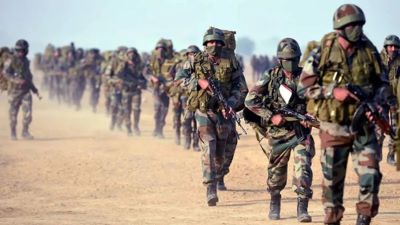Context-
The Indian Army's focus on technology absorption in 2024 underscores its commitment to leveraging disruptive technologies (DT) to stay ahead in modern warfare. This initiative, encapsulated under Atmanirbharta (self-reliance), aims to integrate cutting-edge advancements like artificial intelligence, autonomous systems, robotics, and space technology into existing military structures..
Evolution of Warfare: Integrating Disruptive Technologies
In the rapidly evolving landscape of military technology, the Indian Army recognizes the need to complement existing legacy systems with disruptive innovations. Contrary to discarding traditional platforms, the emphasis lies on practical integration, ensuring that new technologies enhance rather than replace time-tested tactics. The key challenge is aligning these advancements with operational strategies to maximize their impact on the battlefield.
Recent conflicts, such as the Russia-Ukraine war, highlight the critical role of strategic employment over technological acquisition alone. Despite initial advantages, Ukraine's tactics failed to sustain momentum against Russia's conventional approach. This underscores the importance of consolidating defense capabilities alongside technological investments. For India, this means synchronizing DTs with indigenous defense upgrades to build a resilient military structure.
Adapting Tactics for Modern Warfare
The efficacy of disruptive technologies hinges on operational adaptations rather than mere technical prowess. Historically, armies have optimized tactics to minimize exposure to enemy fire through dispersion and concealment. In today's high-tech battlescape, survival demands innovative tactics that leverage dispersed operations and electronic warfare.
For instance, the evolution of tank warfare necessitates adaptive strategies to enhance survivability. Tanks must operate in dispersed formations, supported by electronic warfare units to counter aerial threats effectively. Similarly, infantry tactics must prioritize junior leadership to navigate compartmentalized and technology-driven engagements. These adaptations underscore the transformative potential of technology when integrated with dynamic operational frameworks.
Planning for Future Challenges
Effective technology absorption requires a holistic approach that integrates digital solutions within existing military planning. Rather than replacing conventional platforms, future strategies must prioritize technological attributes and vulnerabilities. This proactive planning involves understanding the contextual relevance of emerging technologies and their applications at the unit level.
Beyond technology, macro-level considerations such as organizational restructuring and human resource management are crucial. Cultivating specialists at decentralized levels and fostering civil-military fusion enhance operational readiness. Additionally, robust procurement policies tailored to disruptive technologies ensure sustained integration and innovation within the armed forces.
Sustaining Momentum: Lessons Learned and Future Prospects
While the Indian military strides towards technology absorption, sustaining this momentum demands nuanced insights from recent conflicts. The 'Year of Technology Absorption' is not just a singular initiative but a transformative journey towards self-reliance and strategic advantage. By leveraging disruptive technologies within a comprehensive operational framework, India aims to redefine military readiness in the face of evolving threats.
The Role of Training and Education in Technology Absorption
Central to the successful integration of disruptive technologies is the development of a skilled workforce equipped to harness these advancements. Training and education programs within the Indian military must evolve to include specialized courses on AI, robotics, and cyber defense.
● Skill Development for Next-Generation Warfare
As new technologies redefine warfare dynamics, training programs must adapt to cultivate skills tailored to modern battlefields. This involves equipping personnel with expertise in data analysis, drone operations, and cyber warfare. Moreover, cross-functional training that bridges traditional combat roles with emerging technologies fosters a versatile and adaptive military workforce.
● Collaboration with Academic and Industry Partners
To stay abreast of technological advancements, the Indian military must forge partnerships with academia and industry. Collaborative research initiatives can facilitate knowledge exchange and technology transfer, enabling rapid adaptation of cutting-edge innovations into military applications.
Addressing Challenges
Technology absorption entails addressing multifaceted challenges beyond technological acquisition. Policy frameworks, infrastructure development, and resource allocation play pivotal roles in ensuring the successful integration of disruptive technologies into military operations.
● Policy Alignment and Strategic Planning
Clear policy directives and strategic roadmaps are essential to guide technology absorption initiatives. This involves aligning defense procurement policies with the evolving landscape of disruptive technologies, prioritizing indigenous development, and fostering public-private partnerships to drive innovation.
● Infrastructure and Logistics Support
The integration of disruptive technologies requires robust infrastructure and logistical support. From establishing advanced testing facilities to upgrading communication networks, investing in critical infrastructure accelerates the adoption and deployment of cutting-edge military capabilities.
● Resource Allocation for Research and Development
Adequate funding for research and development (R&D) initiatives is fundamental to sustaining technological innovation. By allocating resources towards DT-focused R&D projects, the Indian military can nurture a culture of innovation and cultivate a pipeline of indigenous defense technologies.
Conclusion:
In conclusion, the 'Year of Technology Absorption' represents a pivotal moment for the Indian military, signaling a strategic shift towards technological sovereignty and operational excellence. By embracing disruptive technologies within a comprehensive framework of training, policy, and infrastructure development, India is poised to strengthen its defense capabilities and enhance national security in an era defined by rapid technological advancements. The journey towards technology absorption is not merely about acquiring tools but about fostering a culture of innovation and adaptation that empowers the Indian military to navigate complex and evolving threat landscapes with confidence and resilience.
|
Probable Questions for UPSC Mains Exam- 1. How does the Indian Army plan to integrate disruptive technologies like artificial intelligence, autonomous systems, and robotics into existing military structures under the framework of Atmanirbharta (self-reliance) for enhanced operational capabilities? ( 15 Marks, 250 Words) 2. What strategic and operational adaptations are necessary for maximizing the impact of disruptive technologies on modern warfare, particularly in areas like tank warfare and infantry tactics? (10 Marks, 150 Words) |
Source- The Hindu








